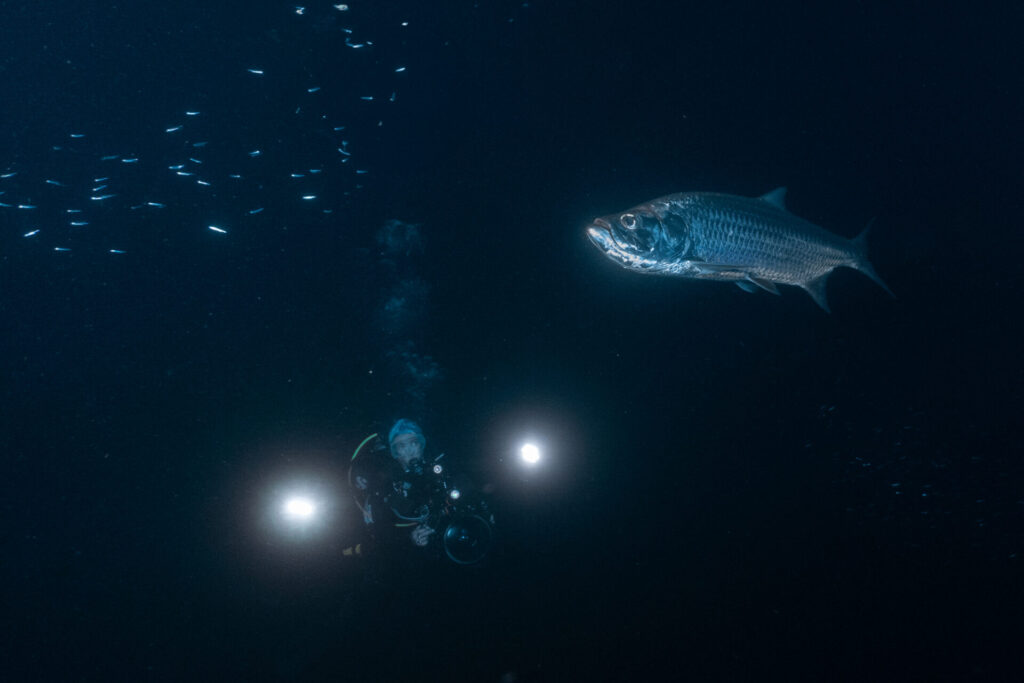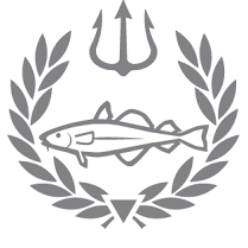At the beginning of the Shootout, Sea Rover and wildlife cinematographer Cristian Dimitrius showed us a short film he had made last time the Shootout was held in Bonaire. It all started when he decided he wanted to try to get footage of the giant silvery tarpon that hunt off the house reef at night. He and the Backscatter guys set up a fake moon by stringing a bunch of lights together and mounting them on a float tied to the dock, with the idea that they’d be able to capture the tarpon in “natural” nighttime lighting. This short film was amazing. The tarpon were zipping around, stalking the small schools of bait fish until they struck. In the dark water with only the “moon” to illuminate them, it looked otherworldly.
Cristian has really expanded my appreciation and fascination for wildlife filmmaking. I watched a lot of nature documentaries growing up, so seeing Cristian present at the Film Festival at the Sea Rovers show blew my mind. His outlook on the shooter’s role as a storyteller and ambassador of nature really resonated with me, and it’s been amazing to have the opportunity to learn from him at the BSR show and at the Shootout.
So, when Cristian said that he’d be setting up a “moon” for some tarpon dives this year, I got really excited. The first night, I decided to watch from the dock rather than dive, given the number of people planning to be in the water. That turned out to be a good call, and I watched the silhouettes of the tarpon glide in and out of the light as they hunted. The divers followed them and I could see the flashes of their strobes as they took photos.
The first night, I decided to watch from the dock rather than dive, given the number of people planning to be in the water. That turned out to be a good call, and I watched the silhouettes of the tarpon glide in and out of the light as they hunted. The divers followed them and I could see the flashes of their strobes as they took photos.
Several nights later, Cristian set up the moon again.  This time, it was only a few of us: Cristian, me, Jemma (this year’s OWUSS photography intern), Backscatter’s Christina Chapman, and Nauticam’s Vicky Liu. We set out the moon and let it be while we geared up, hoping that by the time we got underwater it would have already attracted bait fish. Based on what I had seen from the surface the other night, I was expecting three, maybe four tarpon. But no! After about half an hour, there were probably ten to fifteen tarpon gliding under the light before attacking the schools of small bait fish. They would stalk in and out of the light at the sea floor, and then emerge from the darkness into the water column and snap at the school in a huge gulp. I couldn’t believe what I was seeing! It felt like a nature documentary.
This time, it was only a few of us: Cristian, me, Jemma (this year’s OWUSS photography intern), Backscatter’s Christina Chapman, and Nauticam’s Vicky Liu. We set out the moon and let it be while we geared up, hoping that by the time we got underwater it would have already attracted bait fish. Based on what I had seen from the surface the other night, I was expecting three, maybe four tarpon. But no! After about half an hour, there were probably ten to fifteen tarpon gliding under the light before attacking the schools of small bait fish. They would stalk in and out of the light at the sea floor, and then emerge from the darkness into the water column and snap at the school in a huge gulp. I couldn’t believe what I was seeing! It felt like a nature documentary.
Eventually the lights of the fake moon ran out of battery, but with our video lights on we could still see the hunting tarpon. The bait fish would stay in the light too, so wherever we were was where the tarpon would come to. It was mind-blowing, and we stayed in the water with them as long as we possibly could, until our cameras and lights died at around the two-hour mark.
It was definitely the coolest dive I’ve ever done, and it was an incredibly unique experience that I know will stay with me for a long time. It was also really special to share it with some of the new friends I made at the Shootout! I highly recommend checking out Jemma’s film of the tarpon (this was her final product, like my Christmas Tree Worm video).
— Sofia
